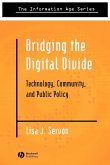The purpose of this study is to explore the extent of the race related digital divide among youth in Nunavut and Nova Scotia, with respect to their access to, use of, and facility with Information and Communication Technologies (ICTs).Data collected from the Equity and Technology Project, gathered through surveys administered to youth in selected high schools in Nunavut (grades 9-12) and Nova Scotia (grades 10-12), are examined. Overall, 2258 youth completed surveys, of which 1675 (or 74.2%) are from Nova Scotia and 583 (25.8%) are from Nunavut.The results of the data analysis show that the digital divide may be most affected by home computer ownership. While Black youth surprisingly spend more time (hours/week), on average, using computers than Whites, there still exists a significant divide in terms of computer facility which is highly related to home computer ownership. The analysis presented in this study uses theories of capital to help explain why, for example, home computer ownership plays a significant role in the development of ICT skills and knowledge in youth.
Bitte wählen Sie Ihr Anliegen aus.
Rechnungen
Retourenschein anfordern
Bestellstatus
Storno








